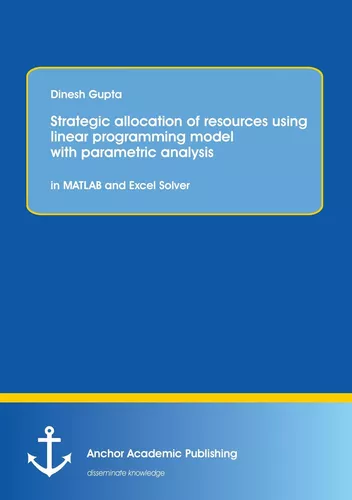Skip to the end of the images gallery Navigation umschalten
Skip to the beginning of the images gallery Navigation umschalten

Strategic allocation of resources using linear programming model with parametric analysis: in MATLAB and Excel Solver
STRATEGIC ALLOCATION OF RESOURCES USING LINEAR PROGRAMMING MODEL WITH PARAMETRIC ANALYSIS
Paperback
76 Seiten
ISBN-13: 9783954892808
Verlag: Anchor Academic Publishing
Erscheinungsdatum: 27.05.2014
Sprache: Englisch
Farbe: Nein
CHF 66.90
inkl. MwSt. / portofrei
Ihr eigenes Buch!
Werden Sie Autor*in mit BoD und erfüllen Sie sich den Traum vom eigenen Buch und E-Book.
Mehr erfahrenSince the late 1940s, linear programming models have been used for many different purposes. Airline companies apply these models to optimize their use of planes and staff. NASA has been using them for many years to optimize their use of limited resources. Oil companies use them to optimize their refinery operations. Small and medium-sized businesses use linear programming to solve a huge variety of problems, often involving resource allocation.
In my study, a typical product-mix problem in a manufacturing system producing two products (each product consists of two sub-assemblies) is solved for its optimal solution through the use of the latest versions of MATLAB having the command simlp, which is very much like linprog. As analysts, we try to find a good enough solution for the decision maker to make a final decision. Our attempt is to give the mathematical description of the product-mix optimization problem and bring the problem into a form ready to call MATLAB’s simlp command. The objective of this study is to find the best product mix that maximizes profit. The graph obtained using MATLAB commands, give the shaded area enclosed by the constraints called the feasible region, which is the set of points satisfying all the constraints. To find the optimal solution we look at the lines of equal profit to find the corner of the feasible region which yield the highest profit. This corner can be found out at the farthest line of equal profit, which still touches the feasible region.
The most critical part is the sensitivity analysis, using Excel Solver, and Parametric Analysis, using computer software, which allows us to study the effect on optimal solution due to discrete and continuous change in parameters of the LP model including to identify bottlenecks. We have examined other options like product outsourcing, one-time cost, cross training of one operator, manufacturing of hypothetical third product on under-utilized machines and optimal sequencing of jobs on machines.
In my study, a typical product-mix problem in a manufacturing system producing two products (each product consists of two sub-assemblies) is solved for its optimal solution through the use of the latest versions of MATLAB having the command simlp, which is very much like linprog. As analysts, we try to find a good enough solution for the decision maker to make a final decision. Our attempt is to give the mathematical description of the product-mix optimization problem and bring the problem into a form ready to call MATLAB’s simlp command. The objective of this study is to find the best product mix that maximizes profit. The graph obtained using MATLAB commands, give the shaded area enclosed by the constraints called the feasible region, which is the set of points satisfying all the constraints. To find the optimal solution we look at the lines of equal profit to find the corner of the feasible region which yield the highest profit. This corner can be found out at the farthest line of equal profit, which still touches the feasible region.
The most critical part is the sensitivity analysis, using Excel Solver, and Parametric Analysis, using computer software, which allows us to study the effect on optimal solution due to discrete and continuous change in parameters of the LP model including to identify bottlenecks. We have examined other options like product outsourcing, one-time cost, cross training of one operator, manufacturing of hypothetical third product on under-utilized machines and optimal sequencing of jobs on machines.
Eigene Bewertung schreiben









Es sind momentan noch keine Pressestimmen vorhanden.